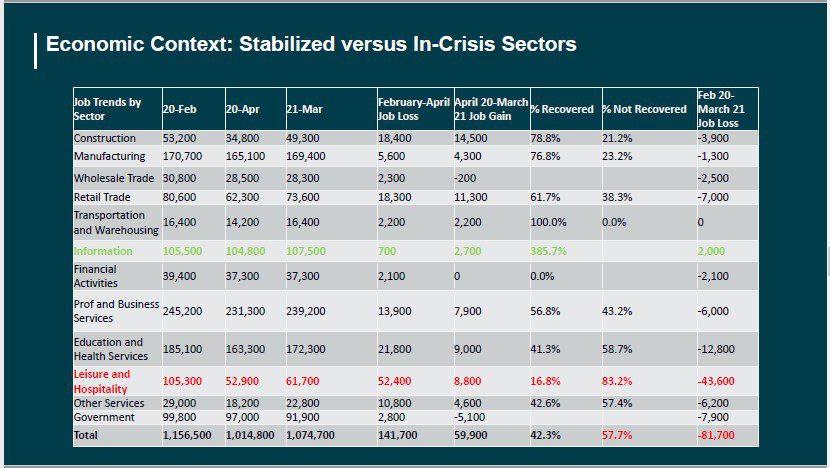Silicon Valley’s unemployment rate is dropping after the economic roller coaster of the COVID-19 pandemic. But some business sectors could take years to rebound.
Local unemployment was below 3% prior to the pandemic, said Bige Yilmaz, economic data analyst for San Jose. After a turbulent year, it now sits at about 5.5%.
“In terms of the unemployment rate, we were quite stable and strong,” she said. “But when COVID hit, in April 2020 everything was closed and the unemployment rate went up to 14.3%. This is an incredible number. When you look at the 2009 recession era, the worst we had was 12.3%.”
Although tech companies expanded during the pandemic and unemployment rates declined, Yilmaz said certain sectors such as retail, personal services and leisure and hospitality are still influenced by long closures.
“As long as there aren’t any more restrictions or closures, there’s no reason to think things won’t get better and the economy won’t start to recover,” she said.
Nima Chhay, labor market consultant with the state’s Employment Development Department, said the number of unemployed people in the San Jose-Sunnyvale-Santa Clara Metropolitan Statistical Area dropped from 128,700 people in April 2020 to 52,300 people in April 2021.


While the pandemic affected employment, San Jose Vice Mayor Chappie Jones said the city is headed in the right direction.
“We’ve seen some progress and I’m very optimistic that we’re going to see that number go down significantly,” Jones said. “Businesses are opening. People are out spending money. Companies are considering hiring. I’m very optimistic the employment picture is going to be a lot better moving forward.”
But Jones acknowledged that challenges remain, such as some people being fearful of exposure to the coronavirus and others being satisfied with their unemployment benefits to not seek work.
Brendan Rawson, a member of the Greater Downtown San Jose Economic Recovery Task Force, said more than 50% of the city’s job losses during the pandemic were in the leisure and hospitality sector. He said any recovery efforts need to address these businesses which have been disproportionately hurt.
According to city data, the leisure and hospitality sector lost 43,600 jobs from February 2020 to March 2021.


San Jose is taking steps to get residents back to work. In May, the City Council unanimously approved a “Return Together” ordinance, mandating hospitality businesses rehire hotel and event workers, among others, when they reopen. The city will rely on worker complaints to keep track of enforcement.
“This past year has been tremendously difficult in this industry,” said Councilmember Raul Peralez, who proposed the policy along with fellow Councilmembers David Cohen and Sergio Jimenez. “The lingering effect here with our service industry is going to be continually felt throughout this year.”
According to Economic and Planning Systems, from the last quarter of 2019 to the second quarter of 2020, downtown sales tax revenues dropped 61%, from about $1.6 million to $640,000. Hotels in the downtown Hotel Business Improvement District, which had 74% occupancy rates in February 2020, saw them fall to 7.8% two months later. In February 2021, occupancy rates were 18.4%, a quarter of what they were a year earlier.
Service workers weren’t the only ones who felt the effects of the pandemic.
Ron Muriera, co-founder of San Jose Arts Advocates, said the pandemic was extremely difficult for performing arts and creative cultural communities, too.
“We’ve seen many of our arts and cultural institutions making difficult decisions to downsize, and that meant staffing,” he said. “In the early period of the pandemic, several of our local arts and cultural institutions had to close their doors, especially the smaller ones.”
He said to weather the storm, some organizations turned to virtual programming to prevent layoffs.
Layoffs were a reality for downtown San Jose businesses during the pandemic, with Team San Jose—which runs the convention center and other cultural facilities—losing 1,304 employees. Other losses were felt at the San Jose Marriott and Hilton San Jose—with 229 and 157 workers laid off, respectively—in addition to numerous other businesses.
In a May 26 letter to the City Council, Rawson wrote that the hospitality sector provides tens of thousands of jobs and hundreds, if not thousands, of small business opportunities for San Jose families.
He said the city needs to act now to generate economic activity that will support hospitality workers rather than wait for business travelers to return. He said the arts, entertainment and sports are good ways to drive local business activity downtown.
“We shouldn’t be waiting years,” he told San José Spotlight. “We need to come up with strategies to support small businesses and workers in this sector. All of us have been impacted, but it has been very uneven.”
Contact Lorraine Gabbert at [email protected].



Leave a Reply
You must be logged in to post a comment.